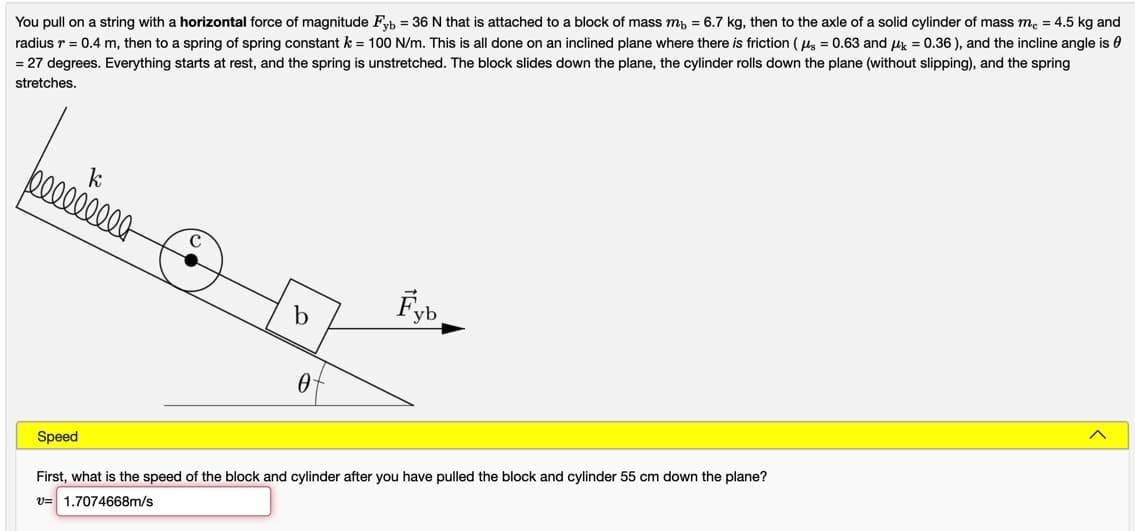then to a spring of spring constant k = 100 N/m. This is all done on an inclined erything starts at rest, and the spring is unstretched. The block slides down the
then to a spring of spring constant k = 100 N/m. This is all done on an inclined erything starts at rest, and the spring is unstretched. The block slides down the
University Physics Volume 1
18th Edition
ISBN:9781938168277
Author:William Moebs, Samuel J. Ling, Jeff Sanny
Publisher:William Moebs, Samuel J. Ling, Jeff Sanny
Chapter8: Potential Energy And Conservation Of Energy
Section: Chapter Questions
Problem 79AP: Consider a block of mass 0.200 kg attached to a spring of spring constant 100 N/m. The block is...
Related questions
Question
I have been stuck on this question for a while. I broke it down into parts and solved for velocity but I think I am doing something wrong.

Transcribed Image Text:You pull on a string with a horizontal force of magnitude Fyb = 36 N that is attached to a block of mass m, = 6.7 kg, then to the axle of a solid cylinder of mass me = 4.5 kg and
radius r = 0.4 m, then to a spring of spring constant k = 100 N/m. This is all done on an inclined plane where there is friction ( ug = 0.63 and uk = 0.36 ), and the incline angle is 0
= 27 degrees. Everything starts at rest, and the spring is unstretched. The block slides down the plane, the cylinder rolls down the plane (without slipping), and the spring
stretches.
p00000000
Fyb
b
Speed
First, what is the speed of the block and cylinder after you have pulled the block and cylinder 55 cm down the plane?
v= 1.7074668m/s
Expert Solution
This question has been solved!
Explore an expertly crafted, step-by-step solution for a thorough understanding of key concepts.
Step by step
Solved in 2 steps with 1 images

Knowledge Booster
Learn more about
Need a deep-dive on the concept behind this application? Look no further. Learn more about this topic, physics and related others by exploring similar questions and additional content below.Recommended textbooks for you

University Physics Volume 1
Physics
ISBN:
9781938168277
Author:
William Moebs, Samuel J. Ling, Jeff Sanny
Publisher:
OpenStax - Rice University

Principles of Physics: A Calculus-Based Text
Physics
ISBN:
9781133104261
Author:
Raymond A. Serway, John W. Jewett
Publisher:
Cengage Learning

Physics for Scientists and Engineers, Technology …
Physics
ISBN:
9781305116399
Author:
Raymond A. Serway, John W. Jewett
Publisher:
Cengage Learning

University Physics Volume 1
Physics
ISBN:
9781938168277
Author:
William Moebs, Samuel J. Ling, Jeff Sanny
Publisher:
OpenStax - Rice University

Principles of Physics: A Calculus-Based Text
Physics
ISBN:
9781133104261
Author:
Raymond A. Serway, John W. Jewett
Publisher:
Cengage Learning

Physics for Scientists and Engineers, Technology …
Physics
ISBN:
9781305116399
Author:
Raymond A. Serway, John W. Jewett
Publisher:
Cengage Learning

College Physics
Physics
ISBN:
9781285737027
Author:
Raymond A. Serway, Chris Vuille
Publisher:
Cengage Learning

Physics for Scientists and Engineers: Foundations…
Physics
ISBN:
9781133939146
Author:
Katz, Debora M.
Publisher:
Cengage Learning

Glencoe Physics: Principles and Problems, Student…
Physics
ISBN:
9780078807213
Author:
Paul W. Zitzewitz
Publisher:
Glencoe/McGraw-Hill